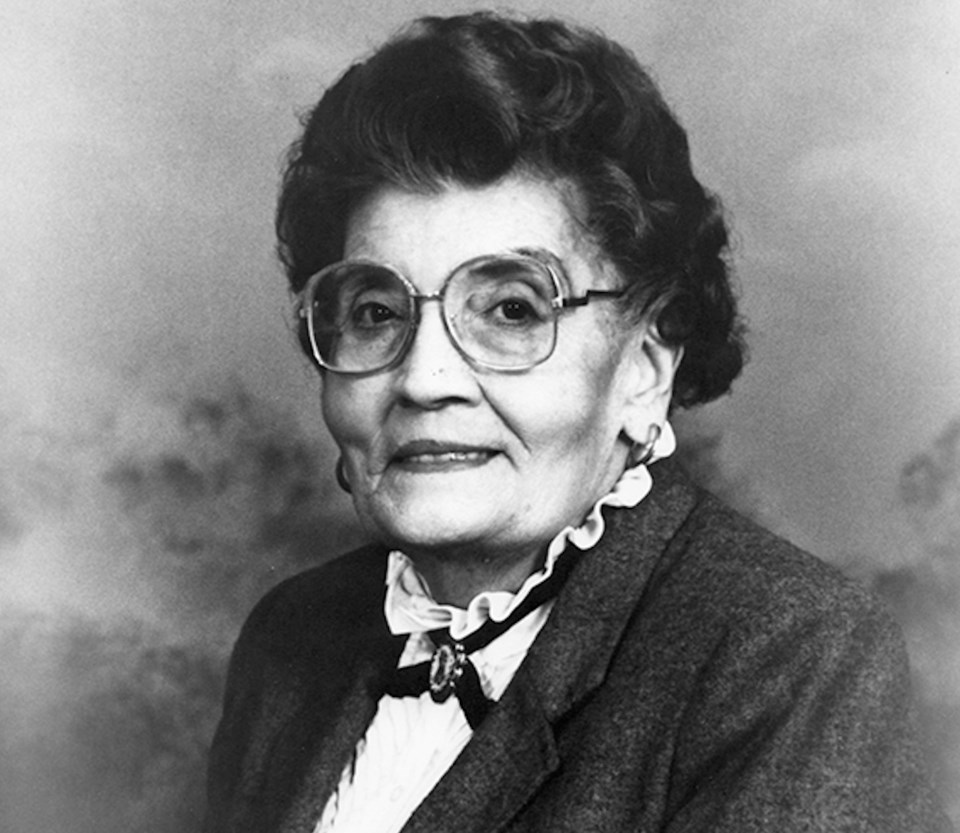In September of 2021, a new high school with a distinguished and historically important St. Albert namesake opened in Edmonton: Dr. Anne Anderson.
Anderson was born in 1906 to a Cree mother and Scottish father, and was raised on a farm a few miles east of St. Albert. The eldest daughter of 10 children, Anderson's early years involved two types of education: the first – from her parents – included how to farm and homestead; and the second, from Bellerose School.
Anderson didn't attend the Bellerose School that exists today, rather she attended the Bellerose School originally built in 1886 in what's now known as the St. Albert neighbourhood of Inglewood. Bellerose School, built by the family of Peter Bellerose, was the first school to operate in St. Albert, and the original building now rests in Fort Edmonton Park.
At the time of her death in 1997, Anderson's resume of accomplishments included an honorary doctorate from the University of Alberta and an Alberta Achievement Award in 1975, and in 1979, she was inducted into the Order of Canada.
So, what did Anderson do to receive these prestigious awards you ask? She devoted the last 30 years of her life to preserving the Cree language.
Anderson's bibliography includes over 90 books, including a 38,000-word Cree-English dictionary, which at the time of publication in 1975 was one of, if not the, most comprehensive documentations of the language to date.
Now, it's important to understand that for centuries Cree has been predominantly an oral-only language. For years the invention of Cree syllabics, the symbols used to write the language, has been attributed to James Evans, a Christian missionary from Manitoba in 1840. However, scholars such as Winona Wheeler from the University of Saskatchewan as well as Cree elders from the Sweetgrass First Nation (also in Saskatchewan) have long contested the Evans story with one that's been passed down orally among Cree people over time.
The story passed down through generations of Cree knowledge keepers attributes the invention of the syllabics to a Cree man named Calling Badger, 10 years prior to Evans.
Anderson's other works include grade-level specific books to help kids learn Cree, including books on Metis history in Alberta, children's colouring books, books of Indigenous knowledge and medicine, and cookbooks, according to an extensive article written on Anderson by Bruce Cinnamon in 2020 for the Edmonton City as Museum Project (ECAMP).
In an interview with Windspeaker journalist Judy Shuttleworth in 1992, Anderson said the years of work she did to preserve the language was a promise she made to her mother before she died.
Two of Anderson's books are also featured in the St. Albert Public Library's collection.
Aside from her prolific writing, Anderson also spent many years teaching Cree to children and adults in classes held in Edmonton public schools.
In Cinnamon's article for ECAMP, he wrote, "Anderson’s first foray into teaching came when she placed an ad in the newspaper offering to tutor people in Cree. She expected to receive only 10 responses, if that, and was blown away when 50 people expressed interest."
After the unexpected enthusiasm for her classes, she opened the Dr. Anne Anderson Native Heritage and Cultural Centre in Edmonton in 1984.
"The centre quickly became a vital community hub, providing not only Cree classes for children and adults, but also serving as a library, a repository of cultural artefacts, and a storefront for Indigenous and Métis arts and crafts," Cinnamon wrote.
In 1979, the St. Albert Historical Society hosted a banquet in recognition of Anderson, and the guest of honour gave a speech recapping her much of her life, and her fondness for St. Albert.
A recording of Anderson's speech is archived at the Musée Héritage Museum, and a transcript of her speech can be read online.
“On our way to St. Albert this evening, I had a most wonderful feeling come over me," Anderson said to the crowd. "It was just like coming home and this is the way I feel each time I come north on what we call the St. Albert trail."
"It’s like coming back to my home."
Anderson explained what her early years were like living on the family farm near St. Albert, and she shared memories of that time, including her father's death when she about 13; her experiences at Bellerose School; her first marriage and subsequent departure to Portland, Oregon before returning to live in Edmonton; and her career as a nurse until her retirement around 1966.
Anderson also explained that her dedication to teaching Cree to new generations was a result of something her mother said to Anderson before she died.
“I lived in Oregon for many years but I wanted to, deep down, I wanted to come back to St. Albert. I was lonely for St. Albert. I was lonely for the snow, for the cold weather," she said.
“I still feel I’m part of St. Albert, and I always will till my dying day.”
When Anderson died in 1997, her funeral was held at St. Albert Catholic Church.
To learn so much more about Dr. Anne Anderson's life, visit the ECAMP website, the archives at the Musée Héritage Museum, and of course, read her books.



